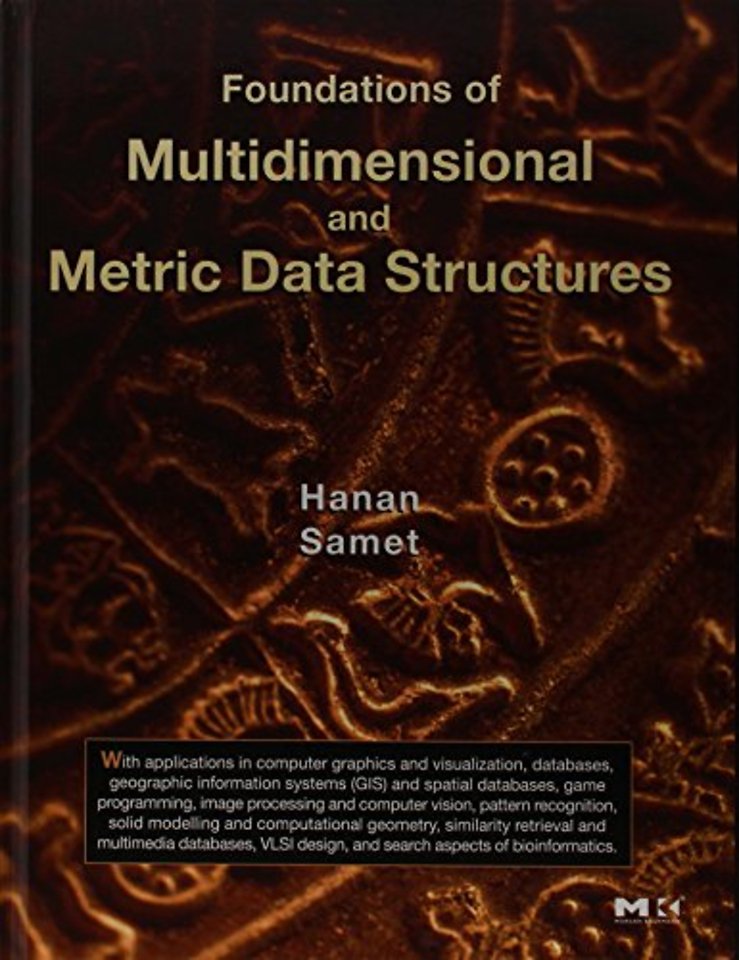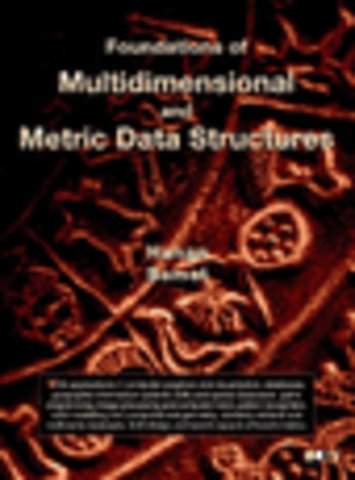



University of Maryland at College Park, author of the pioneering books in this field, The uter Studies.
Meer over Hanan SametFoundations of Multidimensional and Metric Data Structures
Samenvatting
The field of multidimensional data structures is large and growing very quickly. Here, for the first time, is a thorough treatment of multidimensional point data, object and image-based representations, intervals and small rectangles, and high-dimensional datasets.
The book includes a thorough introduction; a comprehensive survey to spatial and multidimensional data structures and algorithms; and implementation details for the most useful data structures. Along with the hundreds of worked exercises and hundreds of illustrations, the result is an excellent and valuable reference tool for professionals in many areas, including computer graphics, databases, geographic information systems (GIS), game programming, image processing, pattern recognition, solid modeling, similarity retrieval, and VLSI design
Features & Benefits:
- First comprehensive work on multidimensional data structures available, a thorough and authoritative treatment.
- An algorithmic rather than mathematical approach, with a liberal use of examples that allows the readers to easily see the possible
implementation and use.
- Each section includes a large number of exercises and solutions to self-test and confirm the reader's understanding and suggest future directions.
- Written by a well-known authority in the area of spatial data structures who has made many significant contributions to the field.
Specificaties
Inhoudsopgave
1.1 Introduction
1.2 Range Trees
1.3 Priority Search Trees
1.4 Quadtrees
1.4.1 Point Quadtrees
1.4.2 Trie-based Quadtree
1.4.3 Comparison of Point and Trie-based Quadtrees
1.5 K-d Trees
1.5.1 Point K-d Trees
1.5.2 Trie-based K-d Trees
1.5.3 Conjugation Tree
1.6 One-dimensional Orderings
1.7 Bucket Methods
1.7.1 Tree Directory Methods (K-d-B-tree, Hybrid Tree, LSD Tree, hB-tree, K-d-B-trie, BV-tree)
1.7.2 Grid Directory Methods (Grid File, EXCELL, Linear Hashing, Spiral Hashing)
1.7.3 Storage Utilization
1.8 PK-tree
1.9 Conclusion
2. Object-based and Image-based Image Representations
2.1 Interior-based Representations
2.1.1 Unit-size Cells
2.1.2 Blocks (Medial Axis Transform,Region Quadtree and Octree, Bintree, X-Y Tree)
2.1.3 Nonorthogonal Blocks (BSP Tree, Layered DAG)
2.1.4 Arbitrary Objects (Loose Octree, Field Tree, PMR Quadtree)
2.1.5 Hierarchical Interior-based Representations (Pyramid, R-tree, Hilbert R-tree, R
-tree, R+-tree, Packed R-tree,R-tree, Cell Tree, Bulk Loading)
2.2 Boundary-based Representations
2.2.1 The Boundary Model (CSG,BREP, Winged-edge, Voronoi Diagram,Delaunay Triangulation, Tetrahedra)
2.2.2 Image-based Boundary Representations (PM Quadtree and Octree,Adaptively Sampled Distance Field)
2.2.3 Object-based Boundary Representation (LOD,Strip Tree,,Simplification Methods)
2.2.4 Surface-based Boundary Representations (TIN)
2.3 Difference-based Compaction Methods
2.3.1 Runlength Encoding
2.3.2 Chain Code
2.3.3 Vertex Representation
2.4 Historical Overview
3. Intervals and Small Rectangles
3.1 Plane-sweep Methods and the Rectangle Intersection Problem
3.1.1 Segment Tree
3.1.2 Interval Tree
3.1.3 Priority Search Tree
3.1.4 Alternative Solutions and Related Problems
3.2 Plane-sweep Methods and the Measure Problem
3.3 Point-based Methods
3.3.1 Representative Points
3.3.2 Collections of Representative Points
3.3.3 LSD Tree
3.3.4 Summary
3.4 Area-based Methods
3.4.1 MX-CIF Quadtree
3.4.2 Alternatives to the MX-CIF Quadtree (HV/VH Tree)
3.4.3 Multiple Quadtree Block Representations
4. High-Dimensional Data
4.1 Best-first Incremental Nearest Neighbor Finding (Ranking)
4.1.1 Motivation
4.1.2 Search Hierarchy
4.1.3 Algorithm
4.1.4 Duplicate Objects
4.1.5 Algorithm Extensions (Farthest Neighbor, Skylines)
4.1.6 Related Work
4.2 The Depth-first K-nearest Neighbor Algorithm
4.2.1 Basic Algorithm
4.2.2 Pruning Rules
4.2.3 Effects of Clustering Methods on Pruning
4.2.4 Ordering the Processing of the Elements of the Active List
4.2.5 Improved Algorithm
4.2.6 Incorporating MaxNearestDist in a Best-first Algorithm
4.2.7 Example
4.2.8 Comparison
4.3 Approximate Nearest Neighbor Finding
4.4 Multidimensional Indexing Methods
4.4.1 X-tree
4.4.2 Bounding Sphere Methods: Sphere Tree, SS-tree, Balltree, and SR-tree
4.4.3 Increasing the Fanout: TV-tree, Hybrid Tree, and A-tree
4.4.4 Methods Based on the Voronoi Diagram: OS-tree
4.4.5 Approximate Voronoi Diagram (AVD)
4.4.6 Avoiding Overlapping All of the Leaf Blocks
4.4.7 Pyramid Technique
4.4.8 Sequential Scan Methods (VA-file, IQ-tree,VA+-file)
4.5 Distance-based Indexing Methods
4.5.1 Distance Metric and Search Pruning
4.5.2 Ball Partitioning Methods (VP-tree, MVP-tree)
4.5.3 Generalized Hyperplane Partitioning Methods (GH-tree, GNAT, MB-tree)
4.5.4 M-tree
4.5.5 Sa-tree
4.5.6 kNN Graph
4.5.7 Distance Matrix Methods
4.5.8 SASH - Indexing Without Using the Triangle Inequality
4.6 Dimension-reduction Methods
4.6.1 Searching in the Dimensionally-reduced Space
4.6.2 Using Only One Dimension
4.6.3 Representative Point Methods
4.6.4 Transformation into a Different and Smaller Feature Set (SVD,DFT)
4.6.5 Summary
4.7 Embedding Methods
4.7.1 Introduction
4.7.2 Lipschitz Embeddings
4.7.3 FastMap
4.7.4 Locality Sensitive Hashing (LSH)
Appendix 1: Overview of B-trees
Appendix 2: Linear Hashing
Appendix 3: Spiral Hashing
Appendix 4: Description of Pseudo-Code Language
Solutions to Exercises
Bibliography
Index
Anderen die dit boek kochten, kochten ook
Net verschenen
Rubrieken
- aanbestedingsrecht
- aansprakelijkheids- en verzekeringsrecht
- accountancy
- algemeen juridisch
- arbeidsrecht
- bank- en effectenrecht
- bestuursrecht
- bouwrecht
- burgerlijk recht en procesrecht
- europees-internationaal recht
- fiscaal recht
- gezondheidsrecht
- insolventierecht
- intellectuele eigendom en ict-recht
- management
- mens en maatschappij
- milieu- en omgevingsrecht
- notarieel recht
- ondernemingsrecht
- pensioenrecht
- personen- en familierecht
- sociale zekerheidsrecht
- staatsrecht
- strafrecht en criminologie
- vastgoed- en huurrecht
- vreemdelingenrecht





